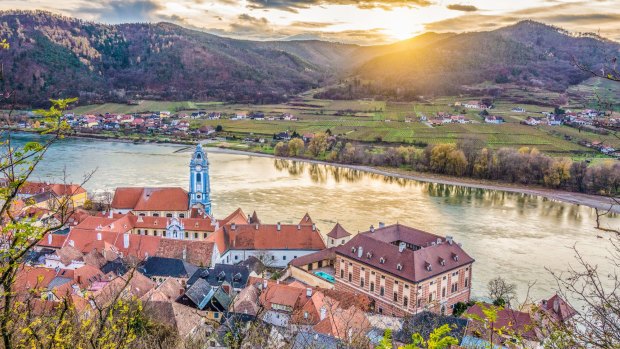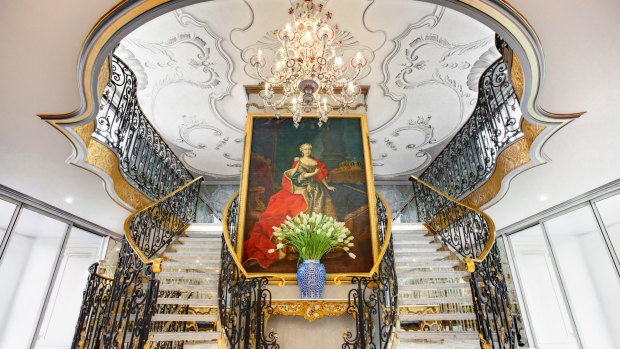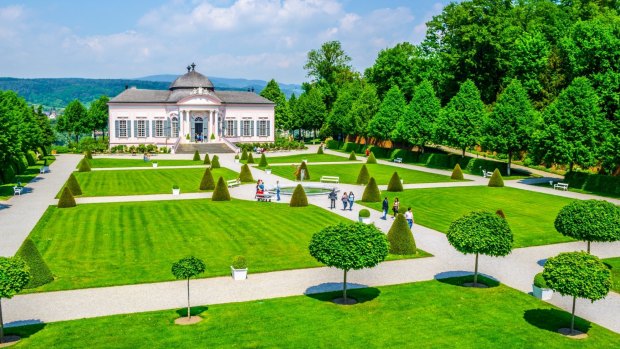This was published 6 years ago
Uniworld's Enchanting Danube cruise: Cruising the happiest river through cities of slow pleasures
By Brian Johnston

Wachau Valley with the historic town of Durnstein and the Danube.Credit: Shutterstock
The Danube is a happy river. At Passau on the edge of Germany, students lounge in cafes on its banks, pleased with their pastel-painted university town and its pastries topped with avalanches of whipped cream.
Downstream in the cheerful Wachau region, the river does a wide, lazy bend rather charmingly referred to as "the smile on the face of Austria".
And at Melk, even dying within sight of the Danube appears a happy business.

The lobby of Maria Theresa, with a portrait of the Austrian empress.Credit: Uniworld
Behind glass cases in the abbey, grinning skeletons in velvet jackets are propped on their elbows as if striving to glimpse the view.
Not just an accident, then, that the signature tune of both the Danube and Vienna is a lively waltz that would make you want to pirouette through a palace.
Mind you, Strauss's Blue Danube is more optimistic than accurate. The Danube is mostly muddy brown and skulks through Vienna's suburbs like an unwanted visitor. This strange aberration apart, the Danube flows right through the centre of many lovely towns and vine-studded valleys between Passau and Budapest.

The garden pavilion of Melk Abbey.Credit: Shutterstock
Making the journey on Uniworld's flagship Maria Theresa is an appropriate way to enjoy it. The ship is decorated like a Viennese palace but thoroughly 21st-century in its comforts. It makes me smile too.
Happiness is popcorn served to me in the ship's cinema; gin and tonic at the Leopard Bar as light-twinkled riverbanks slide past; a lounge whose gilt edges, ruffles and mirrors make me feel I'm in an 18th-century boudoir.
The starting point for our Enchanting Danube cruise is Passau in Germany's southeast corner, where muddy Danube and milky-blue Inn rivers meet.
For a millennium, this was the seat of powerful prince-bishops with a taste for pastels and stone saints dressed as flamboyantly as drag queens.
The ornate cathedral is a masterpiece of plasterwork and gold. Cherubs with skimpy wings pop from pillars, while ceiling frescoes depict toga parties among the clouds.
We're invited to a concert that makes the cathedral's gigantic organ rumble and hoot. The culminating Mendelssohn march nearly takes the roof off.
Back on the Maria Theresa, I tuck into an evening meal of poached salmon in Noilly Prat sauce, stopping short of dessert.
Ship's concierge Richard Torok has recommended the apple strudel at Cafe Anton where, he says, "You'll find yourself somewhere between the flair of turn-of-the-century Vienna and a royal tea time in Buckingham Palace." He's not wrong, and afterwards Passau's old town is agreeably atmospheric.
Saints lurking on dark corners, and unexpected glimpses of moonlit river shimmer at the end of alleyways.
We sail off next day, passing church steeples and villages snug in apple orchards. I sit on the open deck as a waiter brings me a Gregorius Engelszell, one of the ship's several regional beers: this a dark ale that tastes like molasses, made in a Trappist monastery in Austria.
The accompanying landscape is lovely, pastoral rather than dramatic, and takes us towards Linz, whose startling contemporary buildings glow pink and blue in the gathering evening.
At Linz next day, most passengers join coach tours to Salzburg. For me, though, Linz is unexplored territory. The provincial Austrian city is built on eleven hills fronting the Danube River, and Maria Theresa is moored across the road from the baroque main square from which runs Landstrasse, Austria's second-longest shopping street.
It's a lively, agreeable town, and I have plenty of time to wander by myself after joining an informative tour.
"When I went to university in Vienna I was a bit embarrassed to say I came from Linz," admits Uniworld's excellent local guide Silvia.
"Then, in 2009, my hometown became the European Capital of Culture. How much we've changed since! The steel factories have been cleaned up, the arts developed, our new opera house constructed."
We head into the cathedral, on into the newly trendy old town, then along Herrengasse, Silvia's favourite shopping street. "You find small boutiques and interesting shops that are a little more individual. You see Weinbauer here, for traditional dirndls and lederhosen made of stag leather and handstitched. They cost a thousand euros, but you'll own then forever, and your son after you."
A choice of two or more shore excursions at each destination is inclusive on Uniworld cruises; there are also more specialist tours at additional cost. Some shore excursions feature general sightseeing, others "insider" walks, and several active choices include cycling along the Inn River at Passau or Danube in the Wachau Valley.
Cruise director Elke Traumueller Olckers works tirelessly from dawn to dusk (and often beyond) to ensure everything runs smoothly.
We've barely left Linz when we're tracing the smile on Austria's face. I feel decadent as Maria Theresa herself as we approach Melk next morning.
The ship's buffet breakfasts are baroque in their extravagance, from an opening mimosa cocktail to house-made muesli, muffins and croissants, smoked salmon and mackerel, prosciutto and cheeses. Hot dishes range from waffles to omelettes and scrambled eggs with sides of sauteed capsicums and paprika-sprinkled potatoes.
I'm fat and happy as a Hapsburg as we tie up under one of the most staggering monasteries in Europe, mustard-yellow on a great rock above the river. Benedictines have lived here since the 11th century, and Melk Abbey was renowned in the Middle Ages for its scholarship.
Swooning saints and giddy cherubs sweep around the ceilings of its library and church in the ultimate version of baroque excess that makes our rather eye-popping ship's decor seem like a model of restraint.
The Danube slides us onwards towards Vienna through Wachau Valley hillsides covered in apricot orchards and the vineyards that produce Austria's peppery-flavoured gruner veltliner wine.
I sit out on the Bohemian Lounge's terrace at the ship's prow to admire the passing scenery.
A blue-and-white baroque belfry marks the arrival of Durnstein.
Geraniums bloom on 16th-century houses from whose windows local women sell apricot jam and apricots bottled in brandy.
Above looms a ruined castle where Richard the Lionheart was imprisoned: the uphill workout tempers my breakfast overload.
That evening, after a meal of herb-crusted halibut and grilled tiger shrimp, a class in Viennese waltzing in the lounge gets us in the mood for Vienna. The river approach to the city is disappointing; the landscape here is flat, and the Danube channelled away from the city centre. Still, with an overnight here there's plenty of time to explore the Austrian capital's imperial glamour, parks and pastries, music and museums.
That evening we attend a private concert in a city palace: well-known Mozart pieces, an arrangement by Schubert and an apt dose of Johann Strauss the Younger. Naturally, we finish with Blue Danube and a demonstration of waltzing that puts our clumsy efforts of the night before to shame.
Next morning, we have time to ourselves in this music-mad city before sailing downstream over lunch. I attend an interesting lecture in the lounge on the history of Vienna's Jews before we dock at Bratislava. The Slovakian capital is like a village in comparison to Vienna, but has considerable charm and a youthful vibe.
The old town is a delight surrounded by a carapace of grim, Soviet-era apartment blocks.
Our river journey ends at Budapest, not with a whimper but a bang. This is a city of stunning architecture on an imperial scale. From the river that splits hilly palace-topped Buda from flat flamboyant Pest, the city appears in an outline of neo-Gothic spires, palaces and battlemented hillsides, stapled together by gracious iron bridges.
I join another of Uniworld's "do as the locals do" tours which takes us by subway to a market in District 11 to inspect Hungarian delicacies such as salami, paprika and palinka fruit brandy. It's followed by a break at a traditional coffeehouse in the city centre whose delights include cherry strudel and hazelnut cake.
In truth, the cakes on Maria Theresa are just as good, and thoughtfully sliced up into small portions that allow my tastebuds to wander.
My float down the Danube has been accompanied by morsels of Austrian jam roll with poppy-seed sauce, and Hungarian cakes from imperial days such as walnut-and-caramel dobos.
An overnight allows time for both tours and individual wandering.
Budapest is a city of slow pleasures, from stylish cafes and a night at the opera to hot-water public baths.
Parts of the city seem frozen in time from Budapest's grand heyday at the height of the Austro-Hungarian Empire.
But there's also a dark veneer of WWII and Communist history, and a stylish present that makes this one of Europe's most impressive and complicated capitals.
Locals pickle vegetables in jars and set them on their windowsills. Neighbourhood markets burst with fresh food. The younger generation throw themselves into film festivals, fast food and fashion shows, and consider themselves the cool people of Eastern Europe. Budapest's "ruin pubs" turn dilapidated buildings and abandoned public spaces into cheap, retro-hip drinking venues that provide a lively evening out among the locals.
A Uniworld insider tour takes us to the best. Once more I'm in a happy place on this most happy of rivers, sitting over a Szalon Sor beer as bubbles rise.
Uniworld's two 10-day itineraries Enchanting Danube and Munich (which runs between March and November 2018) and Enchanting Danube and Prague (May to November 2018) incorporate city hotel stays followed by a river cruise between Passau and Budapest. Prices from $5599 for an all-inclusive fare. Phone 1300 780 231. See uniworld.com/au
Brian Johnston travelled as a guest of Uniworld.
Sign up for the Traveller newsletter
The latest travel news, tips and inspiration delivered to your inbox. Sign up now.